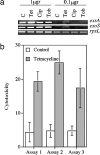Antibiotics as intermicrobial signaling agents instead of weapons
- PMID: 17148599
- PMCID: PMC1682013
- DOI: 10.1073/pnas.0608949103
Antibiotics as intermicrobial signaling agents instead of weapons
Abstract
It has been widely assumed that the ecological function of antibiotics in nature is fighting against competitors. This made them a good example of the Darwinian struggle-for-life in the microbial world. Based on this idea, it also has been believed that antibiotics, even at subinhibitory concentrations, reduce virulence of bacterial pathogens. Herein, using a combination of genomic and functional assays, we demonstrate that specific antibiotics (namely tobramycin, tetracycline, and norfloxacin) at subinhibitory concentrations trigger expression of determinants influencing the virulence of the major opportunistic bacterial pathogen Pseudomonas aeruginosa. All three antibiotics induce biofilm formation; tobramycin increases bacterial motility, and tetracycline triggers expression of P. aeruginosa type III secretion system and consequently bacterial cytotoxicity. Besides their relevance in the infection process, those determinants are relevant for the ecological behavior of this bacterial species in natural, nonclinical environments, either by favoring colonization of surfaces (biofilm, motility) or for fighting against eukaryotic predators (cytotoxicity). Our results support the notion that antibiotics are not only bacterial weapons for fighting competitors but also signaling molecules that may regulate the homeostasis of microbial communities. At low concentrations, they can even be beneficial for the behavior of susceptible bacteria in natural environments. This is a complete change on our vision on the ecological function of antibiotics with clear implications both for the treatment of infectious diseases and for the understanding of the microbial relationships in the biosphere.
Conflict of interest statement
The authors declare no conflict of interest.
Figures


Similar articles
-
In vitro approach to study the synergistic effects of tobramycin and clarithromycin against Pseudomonas aeruginosa biofilms using prokaryotic or eukaryotic culture media.Int J Antimicrob Agents. 2015 Jul;46(1):33-8. doi: 10.1016/j.ijantimicag.2015.02.010. Epub 2015 Mar 18. Int J Antimicrob Agents. 2015. PMID: 25963337
-
Inhibition and destruction of Pseudomonas aeruginosa biofilms by antibiotics and antimicrobial peptides.Peptides. 2014 Dec;62:32-7. doi: 10.1016/j.peptides.2014.09.021. Epub 2014 Oct 5. Peptides. 2014. PMID: 25285879
-
Asiatic acid and corosolic acid enhance the susceptibility of Pseudomonas aeruginosa biofilms to tobramycin.Antimicrob Agents Chemother. 2007 May;51(5):1813-7. doi: 10.1128/AAC.01037-06. Epub 2007 Mar 12. Antimicrob Agents Chemother. 2007. PMID: 17353241 Free PMC article.
-
Subinhibitory concentrations of phenyl lactic acid interfere with the expression of virulence factors in Staphylococcus aureus and Pseudomonas aeruginosa clinical strains.Roum Arch Microbiol Immunol. 2009 Jan-Mar;68(1):27-33. Roum Arch Microbiol Immunol. 2009. PMID: 19507624
-
Pseudomonas aeruginosa: all roads lead to resistance.Trends Microbiol. 2011 Aug;19(8):419-26. doi: 10.1016/j.tim.2011.04.005. Epub 2011 Jun 12. Trends Microbiol. 2011. PMID: 21664819 Review.
Cited by
-
Metallic nanoparticles: a promising novel therapeutic tool against antimicrobial resistance and spread of superbugs.Biometals. 2025 Feb;38(1):55-88. doi: 10.1007/s10534-024-00647-5. Epub 2024 Oct 24. Biometals. 2025. PMID: 39446237 Review.
-
Socially mediated induction and suppression of antibiosis during bacterial coexistence.Proc Natl Acad Sci U S A. 2015 Sep 1;112(35):11054-9. doi: 10.1073/pnas.1504076112. Epub 2015 Jul 27. Proc Natl Acad Sci U S A. 2015. PMID: 26216986 Free PMC article.
-
Sub-MIC of antibiotics induced biofilm formation of Pseudomonas aeruginosa in the presence of chlorhexidine.Braz J Microbiol. 2015 Mar 1;46(1):149-54. doi: 10.1590/S1517-838246120140218. eCollection 2015 Mar. Braz J Microbiol. 2015. PMID: 26221101 Free PMC article.
-
Relationships between the Regulatory Systems of Quorum Sensing and Multidrug Resistance.Front Microbiol. 2016 Jun 16;7:958. doi: 10.3389/fmicb.2016.00958. eCollection 2016. Front Microbiol. 2016. PMID: 27379084 Free PMC article. Review.
-
What counters antibiotic resistance in nature?Nat Chem Biol. 2011 Dec 15;8(1):2-5. doi: 10.1038/nchembio.745. Nat Chem Biol. 2011. PMID: 22173342 No abstract available.
References
Publication types
MeSH terms
Substances
LinkOut - more resources
Full Text Sources
Other Literature Sources

